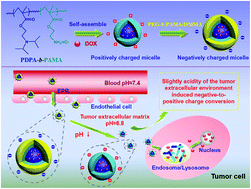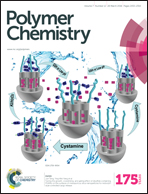Dual pH-responsive micelles with both charge-conversional property and hydrophobic–hydrophilic transition for effective cellular uptake and intracellular drug release
Abstract
The development of pH-sensitive micelles with a tumor-acidity-activated surface charge-conversional property has a great benefit to tumor-targeted therapy. In this study, diblock copolymers, i.e., poly(2-diisopropylaminoethyl methacrylate)-b-poly(2-aminoethyl methacrylate hydrochloride) (PDPA-b-PAMA) and poly(ethylene glycol)-b-poly(2-aminoethyl methacrylate hydrochloride) (PEG-b-PAMA), are synthesized via atom transfer radical polymerization (ATRP). Then pH-sensitive core–shell composite micelles are prepared based on a cationic PDPA-b-PAMA nanoparticle core, which is coated with a 2,3-dimethylmaleic anhydride (DMMA) modified PEG-b-PAMA (PEG-b-PAMA/DMMA) shell. The cationic PDPA-b-PAMA nanoparticle core can effectively enhance cellular uptake and intracellular drug release. Meanwhile, the negatively charged PEG-b-PAMA/DMMA shell could also efficiently prolong the blood circulation time and allow for better accumulation in the tumor area. The molecular structure of the copolymers is confirmed by 1H NMR. The charge-conversional behavior of PEG-b-PAMA/DMMA@PDPA-b-PAMA micelles in a slightly acidic environment is observed by dynamic light scattering (DLS). Transmission electron microscopy (TEM) clearly confirmed that PEG-b-PAMA/DMMA@PDPA-b-PAMA micelles could effectively encapsulate drugs. The drug loading and encapsulation efficiencies of doxorubicin (DOX)-loaded micelles are 14.1% and 82.1%, respectively. The results of cumulative in vitro release indicate that under pH 7.4 and 6.8 conditions, the micellar structure of drug carriers is relatively stable and the drug release is relatively slow. While at pH 5.0, DOX-loaded micelles rapidly disassemble to release the drug due to the protonation of PDPA blocks. In addition, the micellar system also presents distinct cytotoxic behavior to HeLa cells when loaded with DOX. These results imply that pH-responsive PEG-b-PAMA/DMMA@PDPA-b-PAMA micelles with the tumor-acidity-activated surface charge-conversional property are highly promising drug carriers for tumor therapy.


 Please wait while we load your content...
Please wait while we load your content...